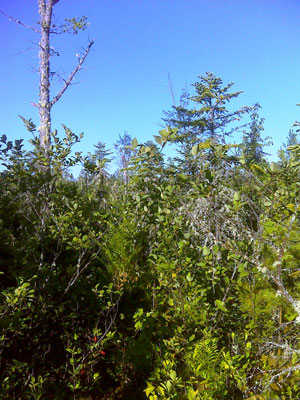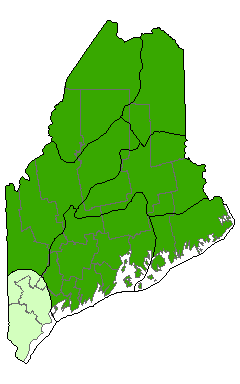DACF Home → Bureaus & Programs → Maine Natural Areas Program → Communities, Plants, and Animals → Natural Community Fact Sheets → Tall Shrub Fen
Printer Friendly Fact Sheet - 800 KB pdf (Get a free copy of Adobe Acrobat Reader)
Tall Shrub Fen
Scientific Name: Mountain Holly - Alder Woodland Fen; State Rank: S4

- Community Description
- Soil and Site Characteristics
- Diagnostics
- Similar Types
- Conservation, Wildlife and Management Considerations
- Distribution
- Characteristic Plants
- Associated Rare Plants
- Associated Rare Animals
- Examples on Conservation Lands You Can Visit
Community Description: This peatland vegetation is characterized by tall shrubs, with spotty tree cover above. Shrub cover is usually >70%, with alder and mountain holly almost always present and with other shrubs locally common. Red maple is typical in the tree layer, along with black spruce. The herb layer is patchy, with 10-50% cover. Labrador tea and pitcher plants are frequent, though not necessarily in high abundance. Cinnamon fern and wild calla are good indicators. The bryoid layer is mostly peat mosses and is patchy, averaging ~50% cover. Back to top.
Soil and Site Characteristics: Sites occur in peat filled basin wetlands, often at the upland/peatland transition. Areas bordering the upland (the peatland “lagg”) have standing water for much of the growing season; however, this community can be found in settings other than the peatland lagg. Substrates are somewhat acidic to circumneutral, with relatively high levels of nitrogen, presumably from the nitrogen fixing alders. Back to top.
Diagnostics: Vegetation associated with a peatland, with well-developed shrub layer (1-3 m) is dominated by non-heath shrubs and often with scattered trees. Some heaths and other peatland species are present. The substrate is peat or is transitional from peat to mineral soil. Back to top.
Similar Types: Alder Shrub Thickets can be similar, but occur on mineral/muck soil and are not associated with peatlands. Sweetgale Fens can have similar structure and can be associated with peatlands, but they are more strongly dominated by sweetgale and heath shrubs rather than alder or other shrubs. Black Spruce Bogs and Red Maple Fens have greater tree cover, less tall shrub cover, and typically occur on deeper peat. Back to top.
Conservation, Wildlife and Management Considerations: This community is common around the perimeter of peatlands and in some non-peatland drainages as well. It often receives runoff from adjacent uplands, so maintenance of appropriate wetland buffers can help retain the quality of individual occurrences.
Wetland species that use this community type include common yellowthroat, Wilson's warbler, Lincoln's sparrow, spotted salamander, wood frog, and northern waterthrush. The black meadowhawk, an uncommon dragonfly of open fens and marshes, may be found in this community. Some occurrences of this community type host vernal pools, which are important breeding habitat for a variety of amphibians including wood frogs, spotted salamanders, and blue-spotted salamanders. The rusty blackbird may occur in this type in northern Maine. Back to top.
Distribution: Central Maine northward, extending west through New England and New York, and presumably north and east into Canada. Landscape Pattern: Small Patch. Back to top.


Characteristic Plants: These plants are frequently found in this community type. Those with an asterisk are often diagnostic of this community.
- Canopy
- Black spruce
- Red maple
- Sapling/shrub
- Balsam fir
- Highbush blueberry
- Mountain holly*
- Red maple
- Speckled alder*
- Wild-raisin
- Dwarf Shrub
- Labrador tea
- Leatherleaf
- Small cranberry
- Herb
- Cinnamon fern*
- Marsh St. Johnswort
- Pitcher plant
- Three-leaved false Solomon's seal
- Three-seeded sedge
- Bryoid
- Sphagnum mosses
There are no documented rare animals associated with this natural community.
Examples on Conservation Lands You Can Visit
| Example | County |
|---|---|
| Acadia National Park | Hancock Co. |
| Appleton Bog Preserve | Knox Co. |
| Great Heath Public Lands | Washington Co. |
| Number Five Bog Public Lands | Somerset Co. |
| Sunkhaze Meadows National Wildlife Refuge | Penobscot Co. |